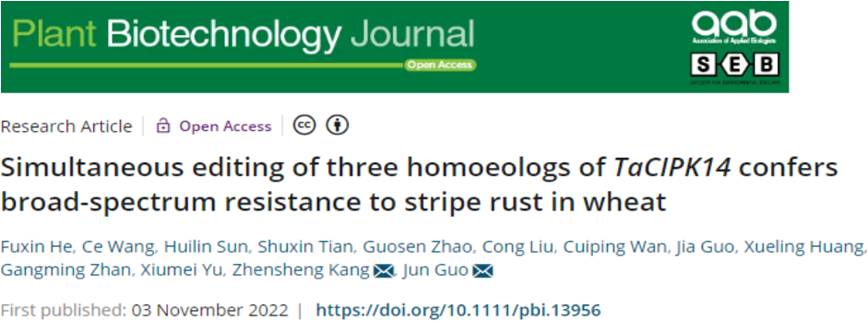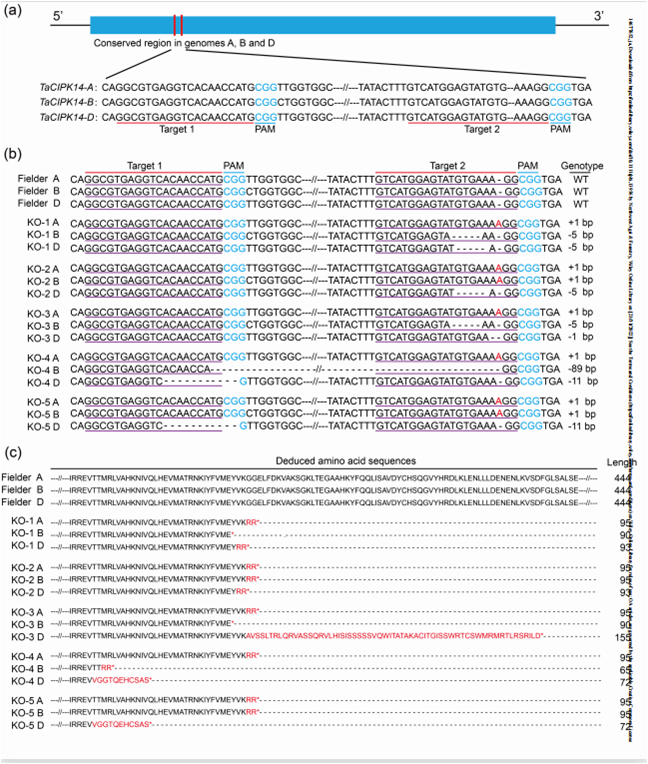On November 3rd, The Plant immunity research team of our institute published the title "Simultaneous editing of three homeologs of TaCIPK14 confers online in the Plant Biotechnology Journal, an internationally renowned academic journal broad spectrum resistance to stripe rust in wheat ". In this study, a stripe rust kinase gene TaCIPK14 was identified and CRISPR/Cas9 gene editing technology was used to create a new broad-spectrum resistance material for wheat. Prof. Jun Guo and Prof. Zhensheng Kang are the corresponding authors of the paper, and Fuxin He is the first author of the paper.

Wheat stripe rust caused by Puccinia striiformis f. sp. tritici (Pst) is one of the most significant diseases in wheat production in China. Planting and cultivating disease-resistant varieties is the most economical and effective measure to control wheat stripe rust. However, due to the inadequate wheat disease resistance resources and the straightforward "loss" of vertical resistance of varieties, traditional breeding for rust resistance is facing great challenges. Therefore, it is urgent to seek new genetic resources, develop new disease resistance strategies, and improve wheat disease resistance to effectively control wheat stripe rust. The susceptibility genes play the function of disease susceptibility by promoting the recognition of pathogens, invading hosts, or negatively regulating plant immune response. Mutation of susceptibility genes via gene editing technology is a new and efficient way to improve plant disease resistance and has become a research hotspot in the international field of plant pathology today.
Calcineurin B-like proteins (CBLs)-binding protein kinases (CIPKs) are involved in regulating various calcium signaling-dependent physiological processes in plants. Previous studies have shown that OsCIPK14/15 is a ploidy gene in rice and is regulating defense responses induced by microbial-related molecular patterns. Sequence analysis revealed that, unlike rice OsCIPK14/15, the homologous proteins TaCIPK14 and TaCIPK15 in wheat showed sequence divergence, implying functional divergence between TaCIPK14 and TaCIPK15. Transient silencing of TaCIPK14 resulted in significantly increased resistance to stripe rust in wheat, accompanied by reduced spore production, increased H2O2 accumulation, and significantly up-regulated expression of disease process-related genes. Further, the transgenic overexpression material of TaCIPK14 was created and inoculated to show increased susceptibility to stripe rust, mainly in the form of increased spore production, reduced reactive oxygen species accumulation, and significantly suppressed expression of disease process-related genes. In summary, TaCIPK14 is a stripe rust susceptibility gene in wheat.

Figure.1 The technology of gene editing CRISPR/Cas9 mediates TaCIPK14 target mutation in wheat
To further clarify the function of TaCIPK14 and its application potential, this study used CRISPR/Cas9 genome editing technology to simultaneously knock out the TaCIPK14 gene in the A, B, and D genomes in hexaploid wheat (Figure 1). The TaCIPK14 mutant strain developed broad-spectrum resistance to five stripe rust minor species, including CYR32, CYR33, and CYR34,



Figure.2 The phenotype identification of TaCIPK14 mutant line in the field
which are currently endemic in China. The results of field trials showed that there was no significant difference in yield-related agronomic traits between the TaCIPK14 mutant strain and the control strain, and the severity of stripe rust in the TaCIPK14 mutant strain was reduced from 64.5% to 51.5% of the control strain after inoculation (Figure 2).
In conclusion, this study used gene editing technology to mutate the wheat stripe rust gene TaCIPK14 and created a broad-spectrum disease resistance material, which conferred a broad-spectrum resistance to stripe rust bacteria in wheat without affecting the yield traits, and provided a new idea for crop disease resistance and improvement.
The research was supported by technical support from the experimental platform of the State Key Laboratory of Crop Adversity Biology in the Dry Zone. It was also supported by the National Key R&D Program of China (2021YFD1401000), the National Natural Science Foundation of China (32172381 and 31972224), the Key R&D Program of Shaanxi Province (2021ZDLNY01-01), the Natural Science Basic Research Development Program of Shaanxi Province (2020JZ-13) and the 111 Project of the Ministry of Education (B07049).